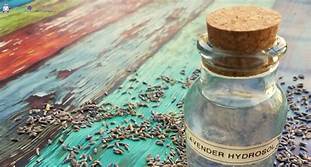





A Question of Scale
The funny thing is that small-scale distribution and handling of hydrosols is easier than large scale. Unless you gear up to transport and store everything in refrigerated trucks, put coolers at the retail outlets, and packaging only under sterile conditions with adequate filtration, you are creating the ideal conditions for problems to arise.
Now, if hydrosols were treated like a foodstuff, or even beer (remember Bud?), then they would be handled in just this manner, but they are usually treated as cosmetics. The public treats very few cosmetics with this kind of elaborate care.
However, most aestheticians will tell you that you should never put your fingers in a jar of cream because you introduce bacteria that will happily grow in a nice rich base.
Do you use a little spatula to scoop your cream or face mask from the jar? Most people don't. So, for the mass market, a real change in thinking must occur if a hydrosol product is ever to become commercially viable.
Enter the grocery store. In the past three years a whole range of healthy beverages have been launched to capitalize on the juice-bar and health-food phenomenon. These drinks contain real fruit and a range of supplements like spirulina, wheat grass, ginseng, Saint John's wort, ginkgo, and so on. they contain no preservatives and have a short shelf life.
It is not uncommon to see them in the cooler right beside the soda pops and iced-tea drinks. These products are changing the way people think about their beverage choices. For many, especially the hip young health conscious and the upwardly mobile, it is these new drinks that fill the shopping cart.
And these consumers pay attention to the dates, and they do drink them quickly, which means they also buy more. These beverages cost more, but that is to be expected of a natural product. It is quite a shift in consumer buying habits, and it has happened in a relatively short time.
Reference: Hydrosols: The next Aromatherapy: Suzanne Catty
Articles - Most Read
- Home
- What are Hydrosols
- What are Hydrosols-2
- The Monographs
- How to Make a Hydrosol
- Table of Common Latin Names and pH Values - F - O
- Distilled or Extracted Specifically For Therapeutic Use - 3
- What isn't a Hydrosol?
- Kurt Schnaubelt
- Table of Common Latin Names and pH Values - P - S
- Wholly Water!
- Blue Babies
- Mature Skin
- Supply and Demands
- Recipes Alpha F
- Hydrosols In The Marketplace
- Hemorrhoids
- Nelly GrosJean
- Chemicals: Friends or Foes?
- Water as Medicine
- Genitically Modified Plants
- Water Quality
- Influences
- The Educated Consumer
Articles-latest
- Comptonia peregrinal/Sweet Fern- pH 3.8
- Citrus clementine (fe) Clementine Petitgrain- pH 4.3-4.4
- Citrus aurantium var. amara (flos) /Neroli Orange Blossom-pH3.8-4.5
- Cistus ladaniferus/Rock Rose-pH 2.9-3.1
- Cinnamomum zeylanicum (ec) Cinnamon Bark-pH3.3
- Chamaemelum nobile/Roman Chamomile - pH 3.0-3,3
- Centaurea cyanus/Cornflower/Bachelor's Button-pH 4.7-5.0
- Cedrus atlantical/Cedarwood/Atlas Cedar-pH 4.1- 4.2
- Hydrosols -The PH - Anomalies
- Hydrosols- Establishing Shelf Life and Stability
- Boswellia carterii/FRANKINCENSE
- Asarum canadense/ Wild Ginger/Canadian Ginger
- Artemesia vulgaris / Artemesia
- ARTEMESIA DRACUNCULUS - TARRAGON
- Angelica archangelica / Angelica Root - Hydrosols
- The Key, or More Correctly, the pH - 2 - Hydrosols
- The Key, or More Correctly, the pH-Hydrosols
- The Hard pHacts - Hydrosols
- Calamus Root/Sweet Flag - ACORUS CALAMUS
- Yarrow - Achillea millefolium - Hydrosols
- Balsam Fir - Abies balsamea - Hydrosols
- How the Monograps are Presented
- The Three-Week Internal Protocol - Hydrosols
- Protocols - Hydrosols

